{Alternate Title for Photos: My (Adult) Life in Trees}
Have you ever been asked the question, “If you had to choose between living near the ocean or the mountains, which would you pick?” I have been asked this question numerous times, and I always have the same answer. Both mountains and oceans are amazing. They inspire a humbling type of awe that is hard to match. However, I know (from growing up near neither) that I can live without them near me. I do need forests. I need trees. I need the leaves, the needles, the understory and the animals that depend on forest ecology to survive.
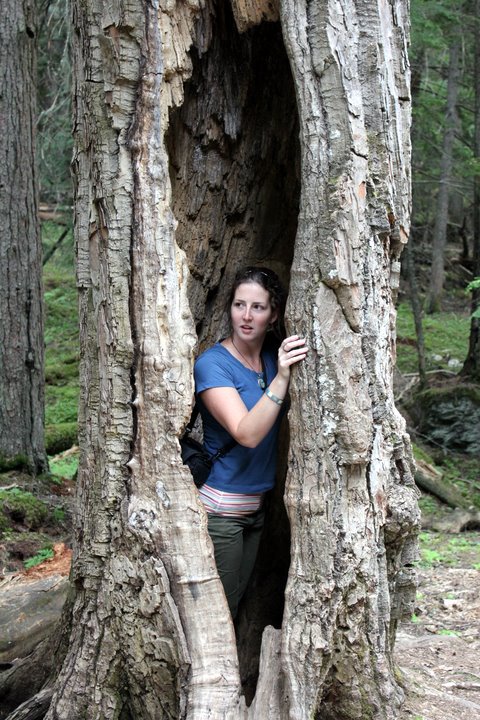
Avalanche Lake, MT, ca. 2010
I remember climbing up into my favorite climbing tree in my yard as a girl and writing in my diary. It had a limb about 25 feet up that fit me perfectly. It seemed that the tree and I grew at similar rates. As the distance between branches lengthened so did I, and as I gained pounds in growth spurts, the branches grew to bear more weight.
Of course, this romantic memory reminds me of Shel Silverstein’s well-known classic The Giving Tree. I read this book often to students and young friends. It almost always makes me tear up a little bit at the end, when the tree has given up everything for the little boy but the tree is still happy.
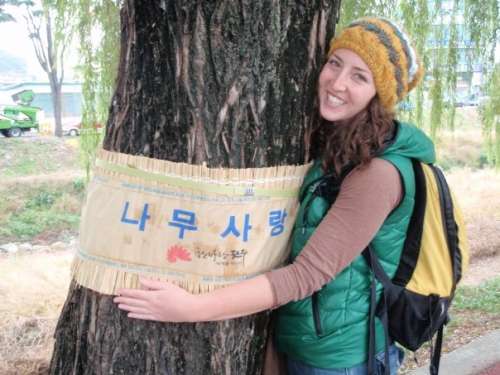
Tree Love, South Korea, ca. 2009
Is this really the case? Are trees here for us to do with them as we please? Aside from the blatant anthropomorphizing of a non-sentient (as far as we know!) living thing, I think trees would like to argue for their own intrinsic value–trees have value for just being trees. Their value doesn’t have to come from how many board feet we can procure from their trunks or how many fruits we can pluck from their branches. Their value doesn’t even have to come from the habitat that they provide other animals or from the precious oxygen they create from our wasteful carbon dioxide.
These thoughts crossed my mind the other day as I stood over a pile of split wood, the “heart” of a tree in one hand, a splitting maul in the other. I kind of felt like one of those disgusting pictures that hunters take where they are holding up the head of their recently slain animal, tongue hanging out of its lifeless face. The child in me that wrote in her diary about boys she liked and softball games she had won cried a little bit at this realization…but the adult in me with cold feet was happy to add to our growing pile of fire wood.
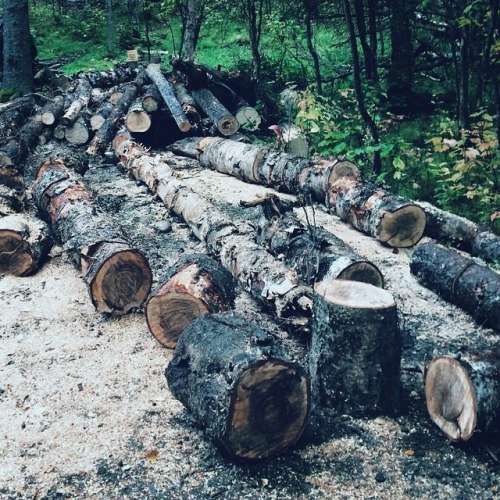
Trees to become warmth for us; ca. a few weeks ago
Growing up with three brothers, I never did much of the physical labor type work at home. It wasn’t because I wasn’t allowed to or anything, I just didn’t have to because there was always somebody else who did it. My brothers and dad mowed the lawn and cut down dead trees and cleaned out the gutters and took out the trash. I think because of this I now love physical labor. I really enjoy mowing lawns. I’ll choose to clean gutters before a toilet any day. And now I would much rather split wood than do the dishes.
Evan taught me to split wood a few weeks ago. I love it. It is empowering and stress-relieving to successfully swing a heavy axe and hear the crack of a round of wood, watching the pieces fly through the air. There are times as a mostly stay at home mother that I think to myself, “is this really my life?” It is generally incredibly rewarding and the best thing I’ve ever done, but sometimes it’s not. Sometimes I want an hour of me. I want an hour where I’m not making sure the baby isn’t eating dog food or about to smack her head again while learning to walk or won’t you just please go to sleep because mommy is slowly going insane. These feelings don’t come often, but I’m not going to lie–they come and they are not fun. I’ve found that splitting wood is good medicine.
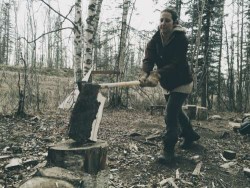
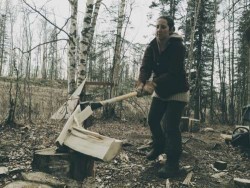
Maybe it’s because I’m new to the whole wood chopping game, but I have to concentrate a lot on what I am doing. I cannot think (at least directly) about how I’m going to get more iron into Ava’s diet, I cannot think about the never ending pile of dishes or the never ending fluff of dog hair that needs to get vacuumed out of the carpet, I cannot even think about the depressing/alarming news about Ebola or ISIS or unwarranted deaths of unarmed teenagers. All I can think about is the perfect position for my feet, keep my eye on the furthest edge of the round of wood, take in a breath and swing as I breathe out–right hand slides up from the neck of the handle to meet the left and THWHACK. If I’m lucky, I end up with two where there once was one–but that isn’t always the case.
There is something incredibly rewarding about stacking these newly split pieces into neat wood piles that grow and grow, only to shrink and shrink in the coming months. How cool is it to see and create (kind of) the fuel that is to keep us warm in the coming months? It isn’t just some liquid coming in through a tube that we only notice when it leaks and smells bad. It doesn’t come from a plant far away through miles of some–presumably magical–electric wires. While I know that most of this power does come from trees and other living things that have been dead for millennia, the intimacy of seeing our fuel from trunk to ash seems more special. I think I am more appreciative of it.
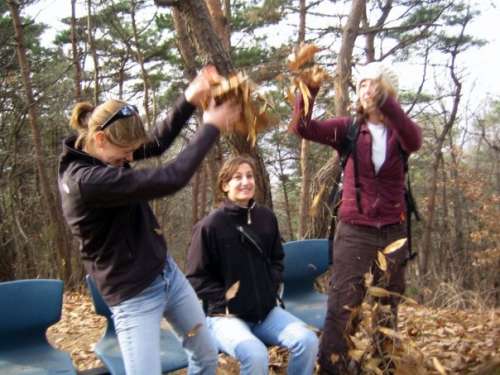
Leaf Fight, Yeoju, South Korea; ca. 2008
It is through this destruction of trees that I come to love them and understand them even more. I can see where a branch started on a tree twenty years ago, still clinging to the heartwood and emerging through the cambium, I can see how the wood slowly dries out, revealing natural lines where the wood will easily split. I can see where the xylem is starting to rot away, no longer needed as new layers of growth provide routes for water and nutrients to travel from roots to branches and back again. I can see where the tree was previously injured and pitch has gathered at the wound, protecting it from infection. I can see how complex these living things really are–even more so than they appear outwardly. How many ravens have played in its limbs? How many leaves have blown from its branches? These answers I cannot know; but in the act of splitting this wood, I think about these things and hope they were numerous.
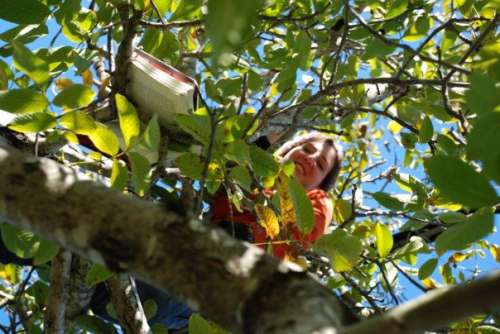
Santa Rosa, CA; ca. 2006
I am currently reading Christine Byl’s Dirt Work thanks to a perfectly timed recommendation from my friend Emma over at myalaskanodyssey. In it, Byl recounts her fifteen years of trail work for the National Park Service in Montana and Alaska. Because of the nature of her work, she fells many trees and describes the process in beautiful detail. She notices the squirrels high in a tree’s branches looking for a quick escape, she notes the way the wind moves the swaying trunk–careful not to get in the way of the heft of old growth as it tumbles down to the earth, and she reflects on the decades of nutrient cycling and seasons that helped the tree grow to huge heights. Like myriad other trees, this tree must fall so humans can be more comfortable–in this case so they can cross a river on a newly repaired footbridge.
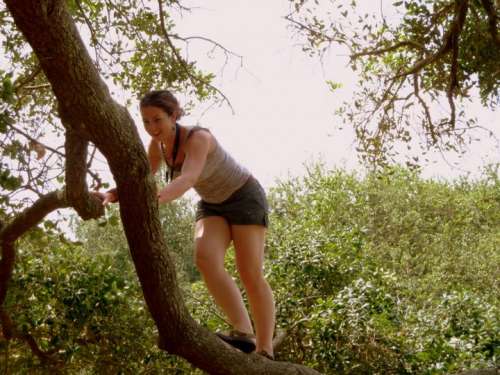
New Orleans, LA; ca. 2011
Does this make it alright? Getting to know and appreciate a tree before downing it? This question is definitely up for debate. I am reminded of a forestry class I took in university. We were split into groups, and each group was assigned the entire above ground portion of a black spruce tree that our teacher had chopped down. We meticulously dismembered these trees–counting whorls, limbs, branches, number of new growth points, even individual needles! Measurements were taken–diameter at breast height, overall height, and the potential number of board feet. It was like dissecting those poor fetal pigs in high school biology class–at least humans give their consent before they become cadavers. But as the Lorax asks, who speaks for the trees? I guess through careful destruction of these unwitting volunteers, the budding group of foresters and I would be able to identify and appreciate living specimens–and presumably we could speak for the trees.
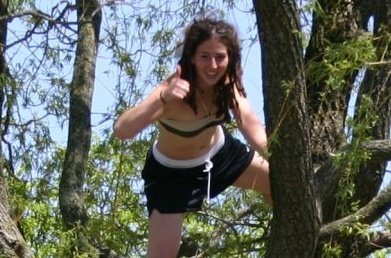
Sheboygan, WI; ca. 2005
What do we end up saying though? This tree stays and that tree goes. If that tree goes others will be able to thrive in its absence. This tree becomes a desk, and that tree becomes toilet paper. This tree stays a tree for another season, and that tree warms a family for a couple of weeks during a cold snap. This tree is going to help frame a home for an elderly couple that lost theirs in a hurricane. That tree is going to grow to the end of its days in the middle of a forest until it falls on its own accord–but will anyone hear it?
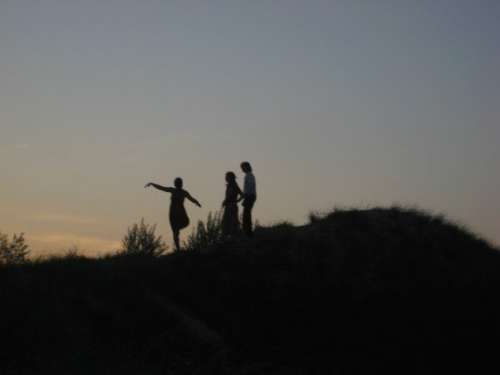
Tree pose in a treeless landscape; Lake Michigan Sand Dunes; ca. 2005
I guess that’s just the nature of trees–to protect and provide for the rest of us whether we be human, beaver, newly hatched chickadee or hungry owl. I just hope that we don’t take too many, too quickly and that we take a moment now and then to think about these trees that make it possible for us to live the lives we live. I also hope that we all know a few trees that are valued just for being trees.
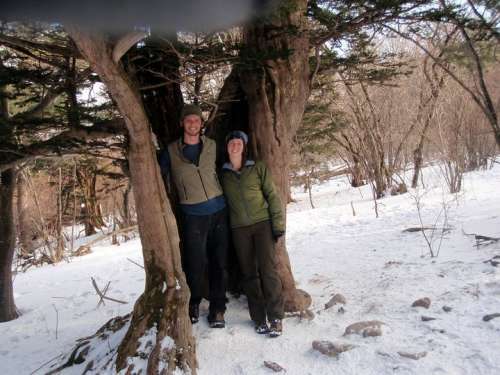
Love in a tree, South Korea; ca. 2010
With all of this speculation, there is one thing I know: I will make a concerted effort to teach my daughter/s how to split wood. It is one of the more empowering skills I’ve acquired and I urge you to learn too, if you haven’t already. Just as it is with many other acts of physical labor, girls and women don’t necessarily learn these skills from “normal” childhood experience, so it is our duty to help change that by teaching the next generation!
I think splitting wood is a perfect Farmgirl Skill–what do you think? do you have any good wood stories? We’d love to hear them!
Until next time,
Sending Peace and Love from Alaska,
Alex, the Rural Farmgirl





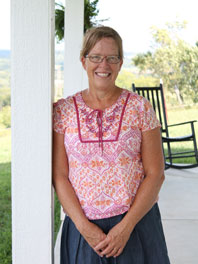
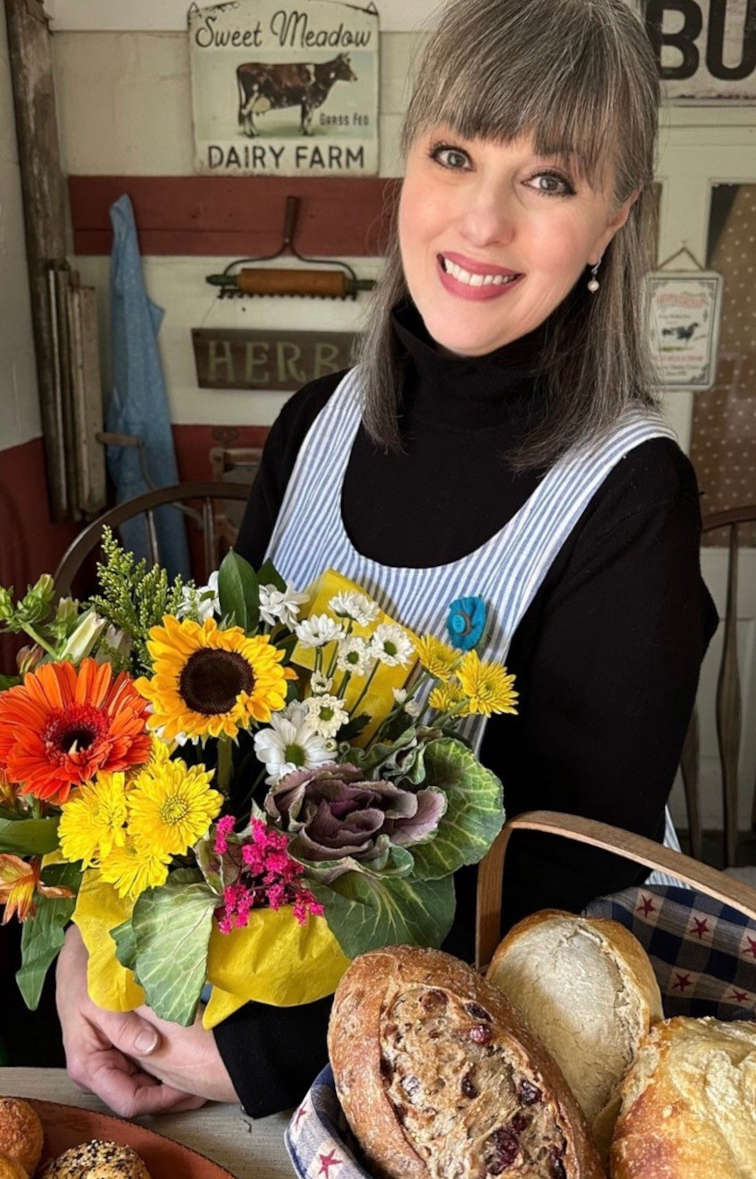
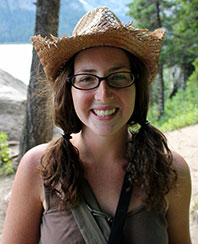
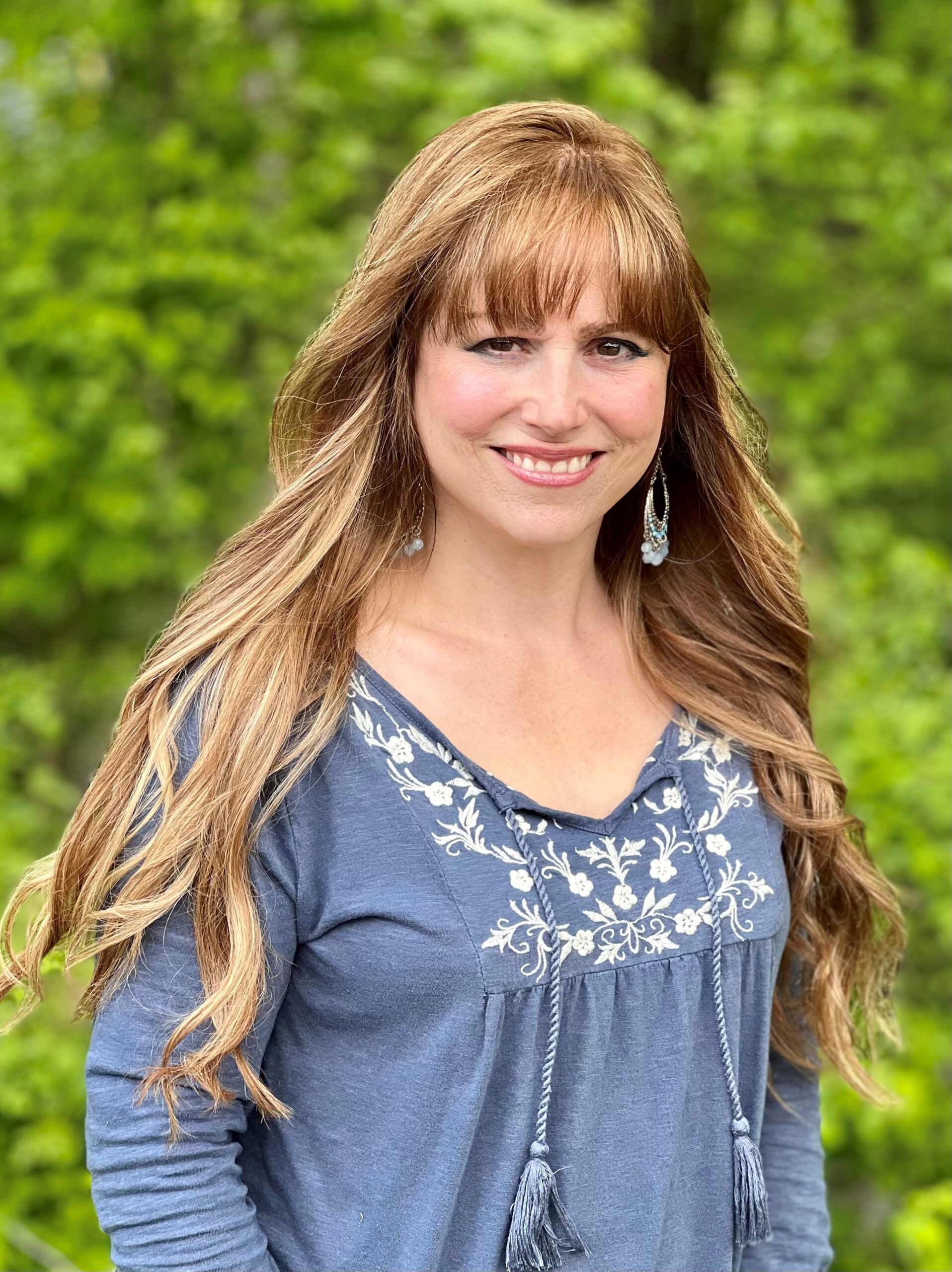


I love your post. I am still working on the splitting wood thing. I always shut my eyes.. You give me hope.
You can do it Karin! I like to think about it like swinging a bat–there are many similarities. Keep your eye on the log!
The area around the Great Lakes has been troubled by the Emerald Ash Borer for many years, resulting in the destruction of many trees. Last year an Ash only a block away had to be cut down and burned. There is an Ash in my yard which I have been checking anxiously every few days all summer. I love that tree and pray for it. I feel sort of like a Lorax at that. The trouble is that the infected trees cannot be used as firewood and some municipalities require that the tree be ground into sawdust. What a waste.
That Emerald Ash Borer has been wreaking havoc forever! I remember the dreaded days when city workers would come and mark ash trees with the dreaded orange tape–Cut this tree down, it’s infected. I hope your tree has enough love and defenses to fend off any trouble.
Good morning Alex,
What a beautiful post. There are so many things I would like to comment on that you wrote, that I don’t know where to begin. First about the daily routines that you are going through raising a family and the daily chores that come with it. I have two boys and I had them while I was working at a very stressful job with one of the largest law enforcement agencies in the country. I do CSI in a forensic laboratory and have done so for over 26 years now. (Hopefully retiring to Montana very soon) And I remember going out to numerous crimes scenes in the worst neighborhoods and processing them. After I was done and had packaged up all the evidence, coming back to the laboratory, going over all the photographs, making sure I had gotten everything I needed, writing up the field notes, etc.. I could not wait to get back home and do all the “daily” chores that keeping a home requires. I could have had the most worst day with my two boys at home that I would never trade for the best day at work. Being at home grounded me against all the craziness I saw in the world. And nothing at home would ever be as stressful as one day at work. I loved doing all those chores at home. And yes I would love to chop wood any day. It is a stress relief. It is good work, healthy and rewarding in the simplest and deepest of terms. I guess I saw both worlds, those of the work force and the life of a parent at home. I have to say, I would chose the life of a parent at home. This is the most rewarding. Your analogy of the life of a tree is so much like the life of us… (Note: I have also felt the same way when reading, “The Giving Tree” to my boys to).
There are no words that I can say here regarding your article that come close to how your article made me feel this morning. Just amazing!!!
Deborah
Thank you, Deborah! Your words are encouraging–you are right, most days I am SO VERY thankful that I am able to be home with my cute little baby. It is grounding and rewarding, as you mention. Your job sounds very intense! As a high school student I had a few lingering thoughts of becoming a forensic dentist (who knows, maybe that will still happen some day!)…So your career intrigues me. I hope you get to retire to Montana, soon!
I love seeing Alex-in-trees over the years! How lucky for little Ava that she has a mama who will teach her all these things that aren’t “girly.” What a great post!
Thanks, Emma!
One of my favorite photos which was on a postcard, is an old-time lady in a long, dark dress, out in front of an old farmhouse. She has an axe held high, which is taller than she is, and is splitting wood! The caption is, “Frailty, thy name is woman” supposedly by William Shakespeare. I,too, love trees, and when the forest behind my house was being clear-cut for pasture, I rode my horse there for the last time on the needle-covered roadbed under the tall, beautiful pines, and apologized… After it was over, I felt as if I were on the moon, and seldom went back there. Not much later, I moved away. But that is an experience I will never forget. “Progress” is often painful. I loved your “tree” pictures and enjoy your stories of your life in Alaska. Thank you.
I love splitting wood…it is such a satisfying skill. My favorite tool is and 8 lb maul, as a lot of the wood we get is gnarled. I give thanks to trees as I do to all the natural things that sustain us…that I won’t take their use for granted, that I will work hard for beyond-sustainable, that their life has value beyond what they can do for us. Every life is precious even though we use some of them to survive.